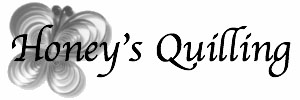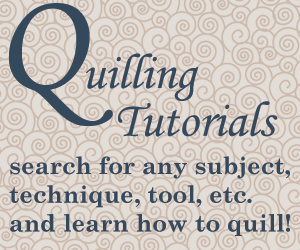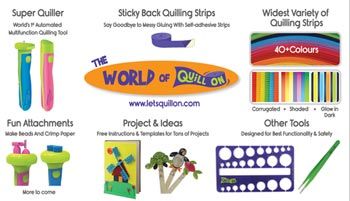When I first started using a topcoat on top of a base sealant for paper quilled jewelry, I was using a type that I bought locally here in Malaysia. It was nice and thin, so it was easy to apply without fearing it would be globby (hm, is that a word? Spell check doesn’t seem to think so!)
There are times when it is really nice to have a thicker sealant. Especially when you are filling in an inset pendant, like this one Svara made. But when you want to coat a piece like an earring that has a lot of empty spaces, and you don’t want them all filled in with the glaze, it is handy to have a thinner glaze!
I was happy when I read on the bottle that Diamond Glaze can be mixed with water. I tried it right away and was pleased with the results! So I decided to try adding water to sealants and glazes to see what would happen!
Here is what I usually do:
- First I squeeze a small amount of glaze into a cap that I use for this purpose.
- Next I drip some water into the sealant. You do not need it to be 50/50, just a few drops will do (or even just one or two drops if it is a small amount of glaze like in the photo). You can always add more if you need to. If you accidentally put in a couple drops too much, just add some more glaze. I started by using this little 1/4 tsp to drip in the water, until I remembered that I had some little plastic droppers
. Now I just use those. So much easier to control! I keep a cup with a little dropper in it near my work area, but another easier option is just to use these little bottles with droppers and keep them filled with water
.
- Stir up the water and glaze with a toothpick or your needle tool. All of the brands I tried out turned a little white and opaque when the water was stirred in, instead of very clear. Not to worry, it will still dry clear!
Then go ahead and use a small stiff paintbrush to paint it onto your piece, or use tweezers to dip your piece into the thin glaze. Allow it to dry and repeat. Because the glaze is thinner, it is better to put on two coats rather than just rely on one.
When I was making these nine pointed star earrings I first started by painting on the Diamond Glaze as it was. The first pair looked okay. But when I got to the second pair, the glaze had already started drying a little bit, so it was a tiny bit thicker. Therefore it ended up getting kind of gloppy on the star, as you can see in the photo below on the right. Not quite what I was going for! So I thinned the glaze and the result of the thin glaze is the one you see on the left. MUCH nicer! It has two layers of the thinned glaze on it.
So, which glaze does this work for? Here is what I have tried so far:
YES, it works:
NO, these don’t work:
- PPA Matte (click here to see what happens when you add water to PPA matte)
I’m guessing that something in the solution for making the PPA matte makes it so that you can’t thin it with water. But all of the glossy glazes that I tried worked just fine when mixed with water. So if you are looking for a smoother finish and having problems with gloppy glaze, try thinning it!
Have you ever tried this method? Did it work for you or not?
Stick around, there is lots to see around the blog! Here are some places to start:
- Click here to view free paper quilling tutorials!
- Click here to view paper quilling tips and tricks!
- Click here to view a list of places to buy quilling supplies around the world!
- Click here to view some of my own quilling projects, with tips so you can make your own if you’d like!




























